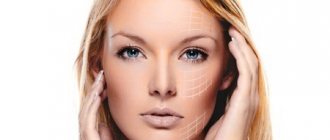Youth, as you know, is a state of mind. It’s wonderful when everything inside you sings and enjoys life. But if on your face, pardon the pun, all the signs of age are “present” in the form of wrinkles, folds, flaccidity and drooping tissue, it is difficult to maintain youthful enthusiasm and confidence in your attractiveness.
Fortunately, modern aesthetic medicine can offer many ways to give your face a second youth. The most effective methods include facial plastic surgery, namely a circular lift.
A circular facelift, or facelift, is one of the oldest and most popular surgical rejuvenation techniques. This operation involves removing excess skin and fatty tissue, returning soft tissues to their original position and giving the contours of the face their former clarity.
The natural result of a facelift is a visible rejuvenation of the face by ten years or more.
Indications for a circular lift
It is believed that this operation is intended for women and men (and men, although less often, also resort to facial plastic surgery) over 50 years of age. However, sometimes the age in the passport and the actual condition of a person’s skin do not correlate. Therefore, if the patient has indications and desires to undergo a facelift, the operation is also performed on people under 50 years of age. Such indications may include anatomical features, the condition of adipose tissue, excess skin, etc.
Good reasons for performing a circular facelift are:
- skin creases in the cheek area;
- pronounced expression wrinkles;
- deep wrinkles in the area of the nasolabial triangle;
- “swollen” oval of the face, “shaved”;
- ptosis (drooping) of the cheek-zygomatic region;
- loose skin, sagging skin;
- the presence of excess fatty tissue on the face, chin, neck.
Contraindications to this rather radical surgical procedure are blood diseases, cancer, dermatological and infectious diseases, diabetes mellitus and other severe chronic illnesses in the decompensation stage, and pregnancy.
1 Consultation with a plastic surgeon
2 Consultation with a plastic surgeon
3 Consultation with a plastic surgeon
Types of circular lift
Classic face lift (rhytidectomy) . With this type of facial plastic surgery, the surgeon makes surgical incisions in the area of the scalp of the forehead, in the fold in front of the auricle and behind the ear. The technique involves manipulations to move, redistribute and give the desired position to tissues with subsequent tension of the skin. No work is done with the muscular frame during rhytidectomy, so the method is applicable mainly to patients with moderate age-related skin changes and without excess fatty tissue.
The operation is usually performed within 1-3 hours, under general or combined anesthesia.
The results of a facelift can last up to 5-7 years (if you follow all medical recommendations for facial care).
With a classic circular facelift, soft tissue and skin are plasticized, but the facial muscles are not involved. And after several years, the skin, under the weight of the muscles, is able to return to its previous (relaxed) state. Therefore, recently, surgeons are increasingly resorting to combined techniques that combine the techniques of classic facelift + SMAS lifting or endoscopic facelift and other techniques.
Deep circular lift (SMAS-lifting) . The technique combines elements of classic facelift and work with the deep layers of the face - muscles and tendons. (SMAS is an abbreviation for Superficial Musculo-Aponeurotic System, i.e. superficial muscular-aponeurotic system).
Manipulations with the SMAS layer make it possible not only to get rid of wrinkles and folds, but also to strengthen the muscular frame of the face and return it to its original relief.
The operation takes 3 hours (on average) and is performed mainly under general anesthesia.
The effect of a deep circular lift lasts much longer than that of a classic rhytidectomy - for 8-10 years or longer.
Circular lift. Photo before surgery
1 Photos before circular facelift
2 Photos before circular facelift
3 Photos before circular facelift
Circular lift. Photo after surgery
1 Photos after a circular facelift
2 Photos after a circular facelift
3 Photos after a circular facelift
Endoscopic facelift. With this type of facial plastic surgery, the surgeon works with the same tissues as with SMAS lifting. Only long incisions here replace miniature (1-2 cm) punctures, through which all manipulations are carried out using the finest endoscopic equipment and a video monitor. The doctor sequentially isolates the muscular aponeurotic layer and then tightens it along with the adjacent skin flaps.
The duration of the operation and the type of anesthesia depend on the scope of the intervention.
The advantages of endoscopic lifting are noticeable rejuvenation, invisible stitches and short rehabilitation. However, the technique is suitable mainly for people 35-45 years old. For older patients with pronounced deep wrinkles, more radical techniques are recommended that allow surgical excision of excess skin.
Combined facelift . When using a combined technique, the plastic surgeon touches not only the superficial tissues near the outer edge of the masseter muscle, but also the deep tissues up to the masseter muscle.
The use of different techniques (tissue mobilization at the SMAS level, movement of muscle-fibrous structures in different directions, excision of excess skin, neck lift, etc.) allows you to correct deep and superficial tissues, stretching them in different directions.
The duration of the operation depends on the complexity of the chosen techniques and can be 2-6 hours. Anesthesia - general.
Photo before a circular lift
1 Photos before circular facelift
2 Photos before circular facelift
3 Photos before circular facelift
Photo after a circular lift
1 Photos after a circular facelift
2 Photos after a circular facelift
3 Photos after a circular facelift
Skin care after surgery
Cosmetic and hardware procedures will help to restore the skin as quickly as possible after a facelift. They can be carried out (with the exception of physiotherapy) after the main rehabilitation period has ended. The following manipulations are allowed:
- physiotherapy – microcurrents (3-4 days after surgery), ultrasound (2-3 weeks),
- lymphatic drainage, electrostatic massage – 25-30 days after surgery;
- use of professional cosmetics (peelings) – after 2-3 months;
- injection procedures (mesotherapy, plasma therapy, Botox) – after 3-5 months.
Compliance with all rules for facial skin care, compliance with medical prescriptions, and supporting procedures is the key to quick recovery and satisfaction with the result of a facelift.
Methods of facial rejuvenation by zones
Often patients do not decide to undergo a full circular facelift or do not consider such an intervention necessary. “Is it possible to rejuvenate the face by zones?” is one of the most popular questions asked to a plastic surgeon. Yes, modern techniques allow this.
Such manipulations include:
- front lifting (lifting the upper part of the face);
- check-lifting (mid-face lifting);
- S-lifting and max-lifting (lifting the lower face and neck);
- space lifting (lifting the middle and lower part of the face).
Front lifting. This aesthetic technique is used to eliminate the first signs of aging. Typically, patients aged about 40 years old with pronounced transverse wrinkles on the forehead, folds between the eyebrows, drooping eyebrows and lower eyelid resort to it.
During the operation, the surgeon tightens the tissues of the upper part of the face. After wrinkles on the forehead are smoothed out and eyebrows are raised, the patient's face becomes more youthful and open.
On our website you can learn more about forehead lift techniques.
Photo before a circular facelift
1 Photos before circular facelift
2 Photos before circular facelift
3 Photos before circular facelift
Photo after a circular facelift
1 Photos after a circular facelift
2 Photos after a circular facelift
3 Photos after a circular facelift
Check-lifting . Used to combat signs of aging in the midface such as:
- hernias (bags) under the eyes;
- sagging cheeks, “shaved”;
- pronounced nasolabial folds.
The technique helps remove small and medium wrinkles, eliminate sagging skin and swelling of the face. It is advisable to carry out check-lifting in combination with blepharoplasty, since the incisions run along the ciliary edge of the lower eyelid.
During the operation, the muscle tissue is fixed in the required position using special endotin plates (3.5-4.5 mm in size). Resorption of endotins occurs within a year, during which time connective tissue has time to form.
The intervention is performed under general anesthesia and lasts up to 1.5 hours. The result of such a lift lasts 6-7 years.
S-lifting. This operation is also called a short-scar or short-flap lift. S-lifting allows you to lift the lower part of the face, get rid of jowls and double chins, and make the lower contour of the face noticeably clearer.
The operation begins with an incision behind the ears or in front of the auricle. Next, the surgeon isolates and tightens the tissues of the SMAS layer, which are attached with hanging sutures to the periosteum of the zygomatic bone.
The advantages of the S-lift: despite its low invasiveness, it is almost as effective as the SMAS lift. Disadvantage: the technique is not suitable for older patients with pronounced wrinkles.
Max lifting . This is a variant of the S-lift, a facelift through minimal access. This technique is a kind of “compromise” between conventional rhytidectomy and SMAS lift.
During max-lifting, excess skin is excised and the deep structures of the face are tightened. The main advantage of this technique is the ability to perform a full facelift through small skin incisions.
Space lifting (or spatial lifting) . A relatively new type of facelift, a minimally invasive lift of the middle and lower parts of the face (cheekbones, cheeks, nasolabial triangle, lower jaw area, neck).
The movement of tissues during space lifting is carried out strictly along the spaces - the physiological spaces under the facial muscles in the cheek area, the area of the zygomatic bone and the lower jaw. Using endoscopic equipment, the surgeon identifies the spacers, then moves them and secures them in the desired position.
The operation is performed under intravenous anesthesia and lasts on average 2 hours. Space lifting is characterized by a short rehabilitation period (3-7 days).
Photo before a circular facelift
1 Photos before circular facelift
2 Photos before circular facelift
3 Photos before circular facelift
Photo after a circular lift
1 Photos after a circular facelift
2 Photos after a circular facelift
3 Photos after a circular facelift
Is it possible to speed up recovery?
In order for the healing process to be quick and painless, the patient must follow some rules, prohibitions and recommendations. At least during recovery, you should give up bad habits - alcohol and cigarettes, as these products reduce the speed of healing. You will also have to give up sports and physical activity, visiting the bathhouse, sauna, solarium, beach, and taking hot baths. In the first week after correction, you should not wash your hair.
To get rid of swelling faster, it is advisable to remove salt from your diet. Contrary to some myths, you should not take diuretics. But there is no need to reduce water consumption - on the contrary, it is recommended to drink more than a liter of clean drinking water daily. In the first days, it is better to eat light foods that do not burden digestion. Only full compliance with all doctor’s prescriptions will help make recovery short and simple.











